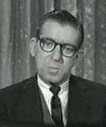➦In 1890... French inventor Edouard Branly coined the term "radioconductor"; the first use of the word "radio".
Experiments with tubes of metal filings, as reported in "Il Nuovo Cimento" in 1884, led to the development of the first radio wave detector, the coherer, by Branly some years later. It was the first widely used detector for radio communication. This consisted of iron filings contained in an insulating tube with two electrodes that will conduct an electric current under the action of an applied electrical signal. The operation of the coherer is based upon the large electrical contact resistance offered to the passage of electric current by loose metal filings, which decreases when direct current or alternating current is applied between the terminals of the coherer at a predetermined voltage. The mechanism is based on the thin layers of oxide covering all the filings, which is highly resistive. The oxide layers are broken down when a voltage is applied of the right magnitude, causing the coherer to "latch" into its low-resistance state until the voltage is removed and the coherer is physically tapped.
The coherer became the basis for radio reception, and remained in widespread use for about ten years, until about 1907. British radio pioneer Oliver Lodge made the coherer into a practical receiver by adding a "decoherer" which tapped the coherer after each reception to dislodge clumped filings, thus restoring the device's sensitivity. It was further developed by Guglielmo Marconi, then replaced about 1907 by crystal detectors.
 |
| Irene Wicker |
➦In 1905...Ireene Wicker born (Died at age 81 – November 17, 1987). She was best known to young radio listeners in the 1930s and 1940s as “The Singing Lady”, which was the title of her radio program. She added the second 'e' in her first name on the advice of an astrologer.
Her radio show was first sponsored by the Kellogg Company, beginning in 1931. Her show was promoted as America’s first radio network program for children. Despite the title of her show, The Singing Lady, most of it involved Wicker telling adaptations of stories for children, ranging from fairy tales by the Brothers Grimm and Hans Christian Andersen through to Rudyard Kipling’s Just So Stories. Also in the 1930s and early 1940s, she portrayed Jane Lee on the serial Judy and Jane on NBC-Blue.
In the 1940s, Wicker was a regular on Deadline Drama on NBC and the Blue Network. In the 1950s, she told stories on Big Jon and Sparkie on ABC radio.
Wicker came to television at WJZ-TV in 1949 with The Ireene Wicker Show in which she told fairy tales. She also had a program, The Singing Lady, on ABC-TV (1948-1950).
➦In 1906...Actor Don MacLaughlin was born in Webster, Iowa. MacLaughlin originated the role of lawyer Chris Hughes on As the World Turns in 1956, and played the role until his death in 1986.
Prior to TV, MacLaughlin was active on radio, beginning in 1933. He starred as the title character on radio's David Harding, Counterspy in the 1940s and 1950s. In 1945, he joined the cast of The Romance of Helen Trent, in the role of Dwight Swanson, "a rancher who becomes interested in Helen Trent."
 |
| Howard Duff |
He died at age 79 on May 28 1986.
➦In 1913...Radio-TV-Film actor Howard Duff was born in Bremerton, WA.
Duff's most memorable radio role was as Dashiell Hammett's private eye Sam Spade in The Adventures of Sam Spade (1946–50).With his TV and film career starting to take hold, he ultimately left the program in 1950 at the start of its final season; Stephen Dunne took over the voice role of Spade.
He died following a heart attack July 8, 1990 at age 76.
 |
| Early WTAW - undated |
➦In 1920...The first radio play-by-play broadcast of a football game was aired by Texas A&M University station 5XB, later known as WTAW in College Station, Texas. The University of Texas defeated Texas A&M, 7-3. The call letters stood for Watch The Aggies Win. Today, the calls are used by a locally-owned station at 1620 AM.
➦In 1926...WLAC Nashville signed-on. The call letters were chosen to contain an acronym for the first owner of the station, the Life and Casualty Insurance Company of Tennessee. Studios were located on the fifth floor of the Life and Casualty building in downtown Nashville. In 1928, it became Nashville's CBS Radio affiliate, while its main competitor, 650 WSM, was affiliated with NBC, the other major Radio network in the early days of broadcasting.

The early years of the station featured, as most big-city stations of that time, network programming, local news, studio-orchestra musical features (accompanied by an in-studio pipe organ), farm reports, and some educational programming. Its main competitor in that era, WSM, became known as the radio station where country music essentially developed and became a national phenomenon. When country music became a big business in the late 1940s, WLAC added early-morning and Saturday-afternoon shows in an attempt to steal some of WSM's thunder. Otherwise, the station prided itself as a pillar of the community and placed emphasis on general full-service programs.
➦In 1926...KVI-AM, Seattle, Washington began broadcasting.

















































